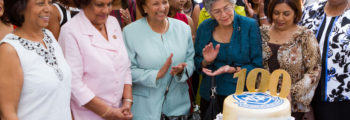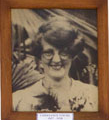1932
Mrs Maude Howell-Dales was appointed the next Principal. Her love for the arts led her to encourage concerts, exhibitions and other public cultural displays. She fostered the school’s reputation for perfection in the arts, particularly drama and music.
1936
Miss Bessie Bentley was appointed the new Principal. Naparima Girls’ High School Alumnae Association was established
1937
The school’s Silver Jubilee was celebrate The Southern Wing was completed. Funding for all new buildings at this time came from the Canadian Women’s Missionary Society. The school’s enrollment stood at 222.
1938
Miss Margaret Scrimgeour was appointed principal. NGHS expanded significantly under her guidance. Thirty teachers were part of the full-time staff and Miss Phoebe Lahouri was appointed as the Vice Principal.
1939
Miss Grace Beattie assumed her tenure as Pr Attendance was increasing and the school urgently needed to expand but Government’s funding was difficult to obtain since the war effort was a strain on the country’s treasury. Two “temporary” wooden buildings were erected to house students. These buildings were used for the next twenty years. The
1948
A Science block and additional classrooms were erected.
1949
Science was introduced to the curriculum with a well equipped lab and qualified staff. The curriculum was expanded to include Spanish, Chemistry, Physics, Biology and Health Science
1950
Miss Margaret Scrimgeour was appointed Principal for the third time.
1954
The Auditorium was completed providing both an upper and lower floor.
1962
The school celebrated its Golden Jubilee.
1963
Cambridge A’ Level classes started at Naparima Girls’ High School.
1964
Miss Beulah Meghu, the first Trinidadian principal was appointed. A great deal of emphasis was placed on developing the full potential of students in a non-competitive atmosphere. The La Pique Revue, the school’s magazine began publication under the guidance of Mrs Mavis Lee Wah. It showcased the creativity, intelligence and achievements of students.
1968
The school’s Student Council was established. A Counselling and Guidance programme was started under Dr. Constance Wagar.
1970
The school first gained National Scholarships
1973
Physical expansion of the school – two modern wings replacing the old buildings. Career Guidance was started Extra-curricular activities were expanded to include netball, chess, modern dancing and steel pan
1985
The expansion of the auditorium was complete
1986
Mrs Mavis Lee Wah was appointed principal. The Parents’ Action Committee was formed. The school’s Inter-House Arts Festival was implemented with categories such as drama, dance, singing, story-writing, photography and this produced entrants to the community’s San Fest Competition.
1986
Mrs. Jean Bahadur was appointed as Principal. She placed great emphasis on teaching and learning strategies.
1987
The school celebrated its Diamond Jubilee and the famous Diamond Jubilee Cookbook was produced
1990

The Sarah Morton Dormitory was refurbished
1992
The school celebrated its 80th Anniversary.
1994
The President’s Award Scheme was started with this school as its base
1995
The start of the four storey block and sealing of a Time Capsule by the Prime Minister of Trinidad & Tobago, The Honourable Patrick Manning.
1997
Naparima Girls’ High School won its first President’s Gold Medal through Sadira Teeluckdharry.
1998
The new prefect system was introduced to encourage all Lower Six students to develop their leadership and organizational skills The opening of the four storey block, by the Prime Minister of Trinidad & Tobago, The Honourable Basdeo Panday. It housed the 6th form classrooms, Art Studios, Food and Nutrition, Computer and Language Laboratory as well as a Cafe
2000
Mrs Patricia Ramgoolam was appointed Principal. The Language and Computer Labs were equipped. Computer Literacy was first introduced on the curriculum for Forms 1 – 3 and Technical Drawing in Lower
2002

90th Anniversary., Launch of the Revised Naparima Girls’ High School Cookbook – The Multicultural Cuisine of Trinidad & Tobago. First President’s Gold medal for non-Science category, Camelia Ram. Acquisition of the School Bus. Start of Confirmation classes. Start of Community Service Programme. Drama and Dance reintroduced to Curriculum. Construction of the new wing – Multimedia room, Conference room. Establishment of
2007
2 President’s Gold Medals, Cherisse Baldeo (Science/Math category) , Nadine Ramharack (Non-Science category). 95th Anniversary celebrations, Heads of Department and Deans formally appointed. Launch of Centenary celebrations
2009
Production of the Musical “Annie” 1st Centenary Cruise
2011
Centenary Cruise II – April Media Launch of Centenary Celebrations – May Publication of “Youth Undaunted” – November Production of the Musical “13 Daughters” – November Grand Reunion – December
2012

Thanksgiving Service to mark the 100th Anniversary of NGHS. Visit of the Canadian Governor General’s wife, Mrs Sharon Johnston. Gala Ball – July, Hyatt Regency. Publication of “Celebrate Food”, a cookbook to complement the world famous Multicultural Cuisine of Trinidad & Tobago. Mrs Carolyn Bally-Gosine, first past student of Naparima Girls’ appointed Principal
2014
CAPE School of the Year Award for 2014 – Naparima Girls’ High School
2015
Dedication and Formal opening of Centenary Wing and Skywalk
1912

The school opened with its first 22 pupils in a small classroom on Coffee Street, San Fernando with Miss Edith Doyle as the first Headmistress and the sole teacher. When Miss Doyle retired six months later, she was succeeded by Miss Marion Outhit M.A., a graduate of Dalhousie University.
1914
With the school’s popularity growing, a small dormitory was created in an existing structure on Coffee Street to house ten girls with Miss Mary John becoming the first matron.
1916
Miss Outhit was succeeded in 1916, by Miss Grace Beattie, an Arts graduate of Toronto University and a deaconess of the Presbyterian Church. Miss Beattie’s vision for the school was one of holistic education, aiming to build sound character through all-round development.
1917 – Sarah Morton Dormitory

With the student population now at thirty-six, expansion became necessary. In 1917 the school moved to more spacious premises at La Pique with three classrooms and a new dormitory, named the Sarah Morton Dormitory in honour of the wife of Reverend John Morton, a pioneer of the Presbyterian Church in Trinidad.
Administrative System
NGHS operated under an administrative system similar to that of Naparima College with a Principal and a headmistress each with distinctive roles.
1917 – Archibald
Miss Adella Archibald was appointed Principal of the school, with her main duty being to supervise and manage the new building project while Miss Beattie continued to function as Headmistress responsible for the school, until 1919 when she was elevated to the post of Principal. Mrs. Amelia Adolphus was appointed as matron of the dormitory
1925 – Tamarind Tree
Planted the now iconic tamarind tree. It was in 1925, that NGHS attained the official status of Secondary School and the first Senior Cambridge class consisting of two students sat the external examination.
1927 – School Uniform

Miss Constance Young was appointed to act as Principal. During her tenure she encouraged participation in the arts and athletics as part of the school’s all round education policy. The enrollment at the school was now over 100. Around this time, a formal school uniform was introduced.
1928
Mrs. Irene Thompson-Kerster was appointed principal




